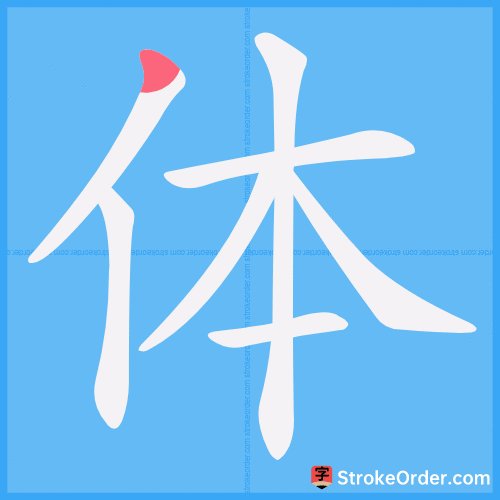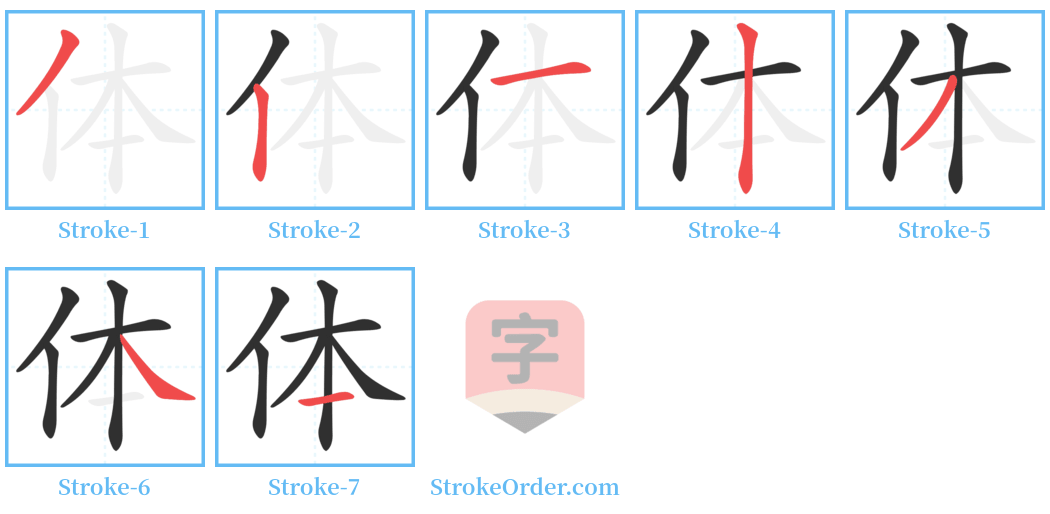体 Stroke Order
Animated Stroke Order of 体

Stroke Order Diagrams for 体

Step-by-Step Handwriting Guide for 体

Learn to Write Chinese Characters with Video Tutorials
Watch the video of writing the Chinese character "体", learn the correct stroke order (笔顺) of the character "体", and master the standard way of writing the character "体".
Free Printable Handwriting Practice with Stroke Order: 体
Printable Writing Practice Worksheet of "体" in Portrait Orientation (Tian Zi Ge)

Printable Writing Practice Worksheet of "体" in Landscape Orientation (Tian Zi Ge)

Information of 体
Pinyin
tǐ、 tī
Radical
亻
Strokes
7 strokes
Usage
★★★★★
Definition
body / form / style / system
体
Definition:
1. 人、动物的全身。
The whole body of a person or an animal.
2. 身体的一部分。
A part of the body.
3. 事物的本身或全部。
The essence or entirety of a thing.
4. 物质存在的状态或形状。
The state or form of material existence.
5. 文章或书法的样式、风格。
The style or form of writing or calligraphy.
6. 事物的格局、规矩。
The pattern or rules of things.
7. 亲身经验、领悟。
Personal experience or understanding.
8. 设身处地为人着想。
Putting oneself in another's situation.
9. 与“用”相对。“体”与“用”是中国古典哲学的一对范畴,指“本体”和“作用”。一般认为“体”是最根本的、内在的;“用”是“体”的外在表现。
In contrast to "use." "Body" and "use" are a pair of categories in classical Chinese philosophy referring to "substance" and "function." Generally, "body" is seen as the fundamental, intrinsic part, while "use" is its external manifestation.
Examples:
1. 人、动物的全身:身~。~重。~温。~质。~能。
The whole body of a person or animal: body weight, body temperature, body quality, body ability.
2. 身体的一部分:四~。
A part of the body: four limbs.
3. 事物的本身或全部:物~。
The essence of a thing: essence.
4. 物质存在的状态或形状:固~。
The state or shape of material existence: solid form.
5. 文章或书法的样式、风格:~裁。
The style of writing or calligraphy: literary form.
6. 事物的格局、规矩:~系。
The pattern or rules of matters: order.
7. 亲身经验、领悟:~知。
Personal experience and understanding: personal knowledge.
8. 设身处地为人着想:~贴。
Considering others: empathy.
9. 本性,本质:如体识。
Nature and essence: inherent understanding.
-
Additional Meanings:
1. 同本义 ([En.] body)
2. 手脚、四肢 ([En.] limbs)
3. 形体 ;体态 ([En.] shape; physique)
4. 牲体 ([En.] body of domestic animal)
5. 事物的主要部分 ([En.] main part)
6. 实体 ([En.] substance)
7. 规格;法式 ([En.] specifications; laws)
8. 占卜时的兆象 ([En.] omen)
9. 本性,本质 ([En.] nature)
10. 准则 ([En.] norm)
11. 文体 ([En.] type of writing; literary form)
12. 体制 ([En.] system)
13. 动词的一套屈折形式 ([En.] aspect of a verb)
14. 文字的书写形式 ([En.] form; style)
15. 立体 ([En.] cube)
动词:
1. 亲身经验;体察 ([En.] personally do or experience sth.)
2. 设身处地为人着想 ([En.] put oneself in another's position)
3. 划分,分解 ([En.] divide; dismember)
4. 成形 ([En.] take shape)
5. 表现;体现 ([En.] show)
6. 效法 ([En.] model oneself)
7. 相承;继承 ([En.] succeed)
8. 生长 ([En.] grow)
9. 包含;容纳 ([En.] contain)
10. 通“履”。体验;实行 ([En.] experience; practice)
11. 另见 tī
people's organization (e.g. labor unions, peasant associations, scholarly associations etc) / mass organization
Input Method for 体
Pinyin
ti3
Wubi
wsgg
Cangjie
odm
Zhengma
nfa
Four Corner
25230
Unicode
U+4f53
Same Pronunciation Characters